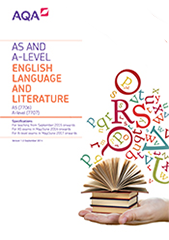Subject content
Our A-level English Language and Literature specification draws on the academic field of Stylistics in order to create an integrated English Language and Literature course which brings together literary and non-literary discourses. This specification integrates literary and linguistic fields via shared concepts about the way language choices create representations, both in literary and non-literary texts: words create worlds, both in literature and elsewhere.
This specification differs from those focused primarily on literature by extending its coverage beyond literature to explore differences and similarities between literary texts and others; it differs from those primarily focused on language by bringing the nature of literary discourse into sharper view. The specification offers unique opportunities to consider issues of 'literariness' and 'literalness' that tend to remain unquestioned in the other Englishes.
This specification offers opportunities for students to develop their subject expertise by engaging creatively, critically and independently with a wide range of texts. Using literary and linguistic concepts and methods, students analyse literary and non-literary texts in a range of modes and genres, in the process gaining insights into the nature of different discourses and ideas about creativity. Students develop skills as producers and interpreters of language by creating texts themselves and critically reflecting on their own processes of production.
The key areas of learning embedded in the specification – the representation of place, point of view and genre in prose, the forms and functions of poetic voice, the role of the individual in society, conflict in drama, creative transformations of texts, researching and writing – will effectively engage A-level students from a wide ability range and help them to develop the key critical, creative and analytical skills required both for progression to higher education and for enhanced employability. The focus of teaching and learning is also guided to some extent by the set text choices, which have all been chosen for their accessibility and position as ideal vehicles for the application of students’ knowledge across these key areas.
The topics and titles of the subject content clearly signpost the key areas of study and separate the content both logically and distinctively. 'Telling Stories' focuses on how and why stories are told, the ways in which writers and speakers present stories, and how language choices help to shape the representations of different worlds and perspectives. 'Exploring Conflict' retains this focus on language choices (which pervades the specification) but looks at how these choices help to construct ideas of conflict between people, and between people and their societies. 'Making Connections' focuses on language use in different types of text and requires students to make active connections between a literary text and some non-literary material. For the purposes of this specification, literary texts are defined as those that are drawn from the three main literary genres of prose fiction, poetry and drama. ‘Non-literary’ is an overarching term which describes more than simply non-fiction. It includes non-fiction but also texts and data that are not formally published and marketed – for example, personal letters, spontaneous speech, multimedia texts. Non-literary texts do not have to occur in continuous prose: they can be charts and diagrams, transcripts, lists.
While the specification aims to maximise flexibility, so that the different components can be sequenced in any way appropriate to the pedagogic context in question, 'Making Connections' is, by its very nature, synoptic, as it requires an ability to make connections across the course as a whole. Exposure to many different texts and discourses from a variety of genres, including the language choices made by students in their own work, will feed into this component, and help enable students to make effective connections between the literary and non-literary texts they choose to examine.
In creating the specification, particular note has been taken of a range of associated factors. These are: the subject criteria for English Language GCSE and English Literature GCSE; subject criteria for GCE English Language and Literature; the benchmarks used for both subjects at higher education level. In this way, the specification is designed to fit within a continuum of study from GCSE to degree level.
In summary, our A-level English Language and Literature specification offers a common core of analytical methods, topics and skills which have proven value, set within a flexible programme which allows schools and colleges to shape learning and teaching in ways appropriate to their particular contexts and constituencies.
